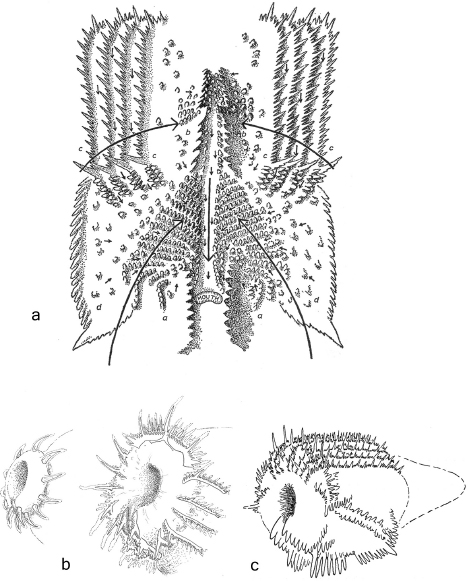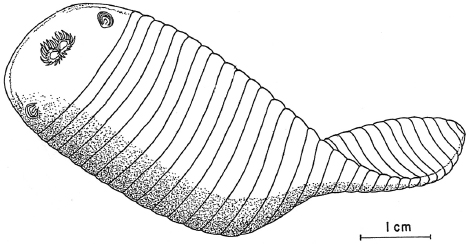The Great Fossil Enigma (43 page)
Read The Great Fossil Enigma Online
Authors: Simon J. Knell


12.2.
Lindström's imagined animals: (a) the conodont lophophore is born in 1964; (b) it developed to fringe the oral cavity of the animal in 1973; and (c) in 1974, this became Lindström's barrel. Reproduced with permission from M. Lindström,
Conodonts
(1964), Elsevier; M. Lindström in
Conodont Paleozoology
(1973), and M. Lindström,
Palaeontology
17 (1974).
The paper demonstrated Lindström's mastery of his field, but he left certain things unsaid. It had occurred to him that the animal forming in his mind looked something like a spiny ostracod. Perhaps the ostracod was mimicking the conodont animal with its armory of tough spines. With this thought his mind, the conodont animal acquired its barrel â or ostracod-like â shape. It was an idea to which he intended to give further thought, but when he did so, it occurred to him there were no predators in that sea capable of seeing with any precision an animal so small. So what use could there be for this kind of mimicry? He laughed to himself and forgot about it. He remained attached to the idea that the conodont elements might support tentacles on a lophophore, but for him the barrel was a rather more ephemeral imagining. It continued to exist, however, in the published paper, there to be the subject of serious debate and occasional ridicule (as Lindström's “toilet roll”) long after that thought had, for Lindström, passed.

Simon Conway Morris was among those who took Lindström's barrel seriously as he pondered a curious fossil from another â the most famous â Lagerstätte: the Middle Cambrian Burgess Shale of British Columbia, Canada.
10
He had chanced upon a sawn slab and put it to one side while searching through the huge Burgess Shale collections at the National Museum of Natural History in Washington. A short while later its counterpart turned up. Conway Morris, who was to build his career on bringing to light the weird and wonderful Burgess Shale fauna, knew this fossil was something special: “The specimen had evidently never been noted by any other worker. No other specimens have been found.” Poorly preserved as a thin film darker than the surrounding rock, this gelatinous, flattened, worm-like animal was a contemporary of the earliest known conodonts. It lacked a distinct head but possessed a curious, almost figure-eight-shaped apparatus within which could be detected the impressions of twenty-five “teeth” very similar in shape to conodont fossils of that period. Unfortunately, most of what had caused these impressions had leached away â a common problem with calcareous fossils in the shale. Nevertheless, Conway Morris thought them conodont-like in size and shape and noted that they too possessed a basal depression and showed some variation in form around the apparatus. He thought this reflected a possible “symmetry transition,” an idea from Lindström's book, which Conway Morris used as his main guide to the conodonts. The counterpart specimen lacked these teeth but instead seemed to show the decayed remnants of tentacles of a kind seen in some other rare fossils. But unlike paleontologists studying common fossils, Conway Morris's science lacked the firm footing of familiarity. He had to decide what constituted informative data on the two specimens and what might have resulted from post-death compaction and alteration. His interpretations depended on his own connoisseurship of fossils and on the work of others â such as Lindström's barrel and transition series, and a 1932 interpretation of tentacles â work he could not know well and relied upon the interpretations of others. These were his building blocks for imagining the animal; in effect, Lindström offered him both spectacles and blinkers. He could not have imagined the animal he now drew without them.

12.3.
Conway Morris's animal. The conodont elements fringing the mouth supported a tentacle-covered lophophore. This lophophore had been reasoned into existence by Maurits Lindström. Reproduced with permission from S. Conway Morris,
Palaeontology
19 (1976).
Conway Morris produced an animal that swam by contracting muscles along its sides much like a modern nemertine worm (
figure 12.3
). The “teeth” were not really teeth. They were too fragile to produce a rasping lophophore, but they may have supported tentacles on a lophophore covered in fine cilia, which directed food toward the mouth. He looked for a modern-day animal group with this same feeding structure and found it in brachiopods, the colonial bryozoans that resemble tiny corals, and a group of sessile worms that live in chitinous tubes. These animals confirmed to Conway Morris that his fossil did possess a lophophore, but they also told him that his animal, which he called
Odontogriphus omalus
(from “toothed riddle”), was not related to any known type of lophophore-possessing creature.
Agreeing with Lindström, Conway Morris dismissed Melton and Scott's animal as a predator of the conodont animal. Now Conway Morris believed
he
possessed the conodont animal. It was rather larger than Lindström had imagined, but Conway Morris felt Melton and Scott's predator could accommodate it. And while Lindström's animal floated, Conway Morris argued that modern animals of similar size possess locomotion. He also did not like the way Lindström had placed his lophophore on the exterior of the animal; he thought this improbable, but he accommodated this by imagining Lindstrom's more complex lophophore as an evolutionary development on that seen in his own animal. By these means, Conway Morris gently shoehorned the nose of his worm onto Lindström's barrel, claiming without fanfare to have found a conodont animal â an animal that could not be allied to any existing group. He saw his animal as ancestral to the conodont animals that blossomed in the Paleozoic and, so he thought from reading Lindström's book, continued up to the Cretaceous. And now a recent discovery in Kazakhstan seemed to take the conodont even further back in time, to the boundary with the Pre-Cambrian.
11
Gould later remarked on Conway Morris's discovery: “What a potential coup for a beginner â to discover the secret of secrets, and resolve a century of debate!” Whether Gould was ever really convinced by this animal is uncertain; most conodont workers were not. This was, however, a science of improbabilities, so ably demonstrated a few years later by a little debate that emerged on the pages of
Science
concerning “conodont pearls.” Tiny phosphatic spheres up to 0.7 millimeters in diameter, each possessing a dimple, had been found in their thousands in the United States and Australia, associated with conodonts and composed of the same layered structure. Brian Glenister, Gil Klapper, and Karl Chauff thought they resulted from irritation caused by detritus or parasites.
12
They were, it seemed, the equivalent of the oyster's pearl and perhaps akin to the balls associated with Müller's
Westergaardodina.
Duncan McConnell and David Ward at Ohio State University were unconvinced, reasoning that these spheres were the nautilus-equivalent of bladder stones, well known in the modern animal. Glenister and company stood their ground but the topic faded.

It was now possible to think freely again about the animal, to reason from what was known. The field was heating up and the animal was once again a hunted species. But with no fresh discoveries to hand, the hunt took place in acts of quiet contemplation. It was time to imagine.
Julian Priddle, a young zoologist at the University of Reading in the UK, reflected on the similarity of some conodonts to the horny eversible “tongue” of the hagfish. He thought conodont elements acted as skeletal supports beneath a layer of secreting flesh which produced a horny surface layer (
figure 12.4b
). While hagfish lacked this underlying structure, lampreys possessed it. And while the lamprey showed a radial arrangement of these elements, in the hagfish they were arranged symmetrically. Priddle also noted that the structure of pits and striae revealed by recent
SEM
work was strikingly similar to that found in unworn mammalian teeth. In mammals, this pattern was caused by the cells responsible for the secretion of enamel.
A model of concise reasoning, Priddle seemed to suggest that one could have one's cake and eat it: “This reconciles the internal nature of conodonts with a tooth function (whereas it was previously generally assumed that to function as teeth the elements had to be externalâ¦).” Priddle sent Scott a manuscript copy of his paper while the paper itself was in press, but Scott was now in defensive mode. Implicitly, Priddle's model doubted Melton and Scott's discovery, and Scott responded, believing Priddle's mind had been contaminated by the “canard”: “I want to assure you that the animals are for real and that the assemblage of conodont elements occurs precisely where it is reported.” Scott had a series of animal fossils now that showed that the conodont elements grew in size as the animal grew. “For these reasons,” he argued) “I think the search for the animal is over. The questions now are, how did they work and what is their evolutionary significance?”
13
Conway Morris's fossil had emerged in some senses from a blind spot â it had been collected and placed in a museum but had not been studied or analyzed. Günther Bischoff, now at Macquarie University in Australia, also thought he had uncovered a blind spot. He puzzled over some long-known spiked bars and ribbed plates. Walliser had noticed that these spikes mirrored the interior shape of the conodonts' basal cavity. That encouraged Bischoff to develop the idea that these bars were “conodont supporting elements,” which joined together into ribbed plates and together made up the mysterious Conulariids. These animals existed over the same time period as the conodonts and remained difficult to interpret. They are considered part of a group of animals that includes corals and jellyfish. The conodont elements were to Bischoff, then, a covering of the exterior shell of this animal.
14
Jan Hofker at The Hague in the Netherlands compared the structure of conodont apparatuses to those found in a diverse group of microscopic animals known as aschelminthes, which include the tiny soildwelling rotifers. By careful rearrangement he tried to show that they were homologous,
15
using that same visual trick executed by Macfarlane half a century earlier. Few conodont workers would be fooled by such lookalike reasoning.
